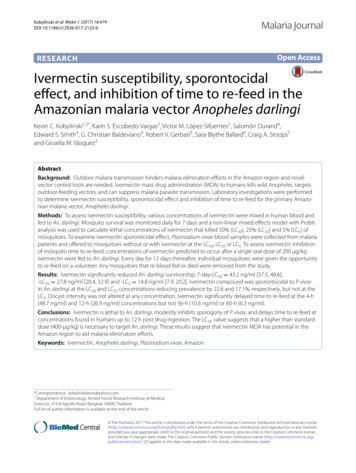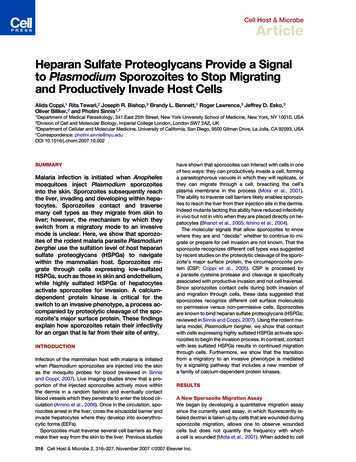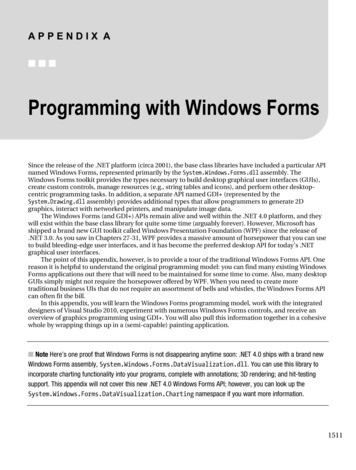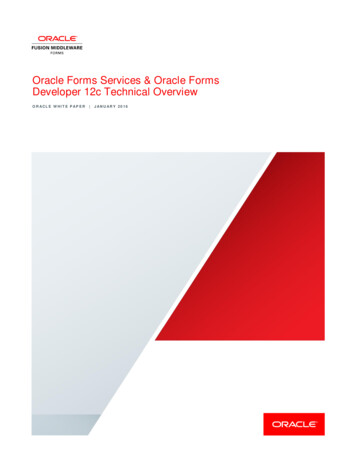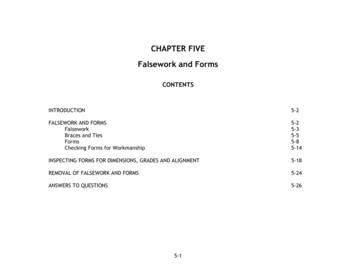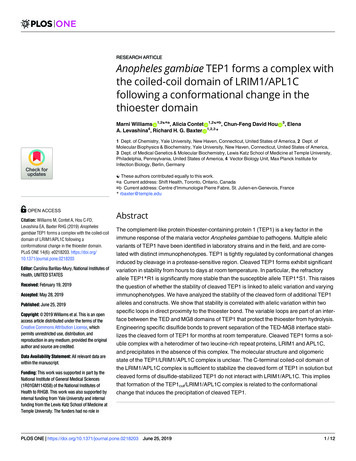
Transcription
RESEARCH ARTICLEAnopheles gambiae TEP1 forms a complex withthe coiled-coil domain of LRIM1/APL1Cfollowing a conformational change in thethioester domainMarni Williams ID1,2 a, Alicia Contet ID1,2 b, Chun-Feng David Hou ID3, ElenaA. Levashina4, Richard H. G. Baxter 11a1111111111OPEN ACCESSCitation: Williams M, Contet A, Hou C-FD,Levashina EA, Baxter RHG (2019) Anophelesgambiae TEP1 forms a complex with the coiled-coildomain of LRIM1/APL1C following aconformational change in the thioester domain.PLoS ONE 14(6): e0218203. : Carolina Barillas-Mury, National Institutes ofHealth, UNITED STATESReceived: February 19, 2019Accepted: May 28, 2019Published: June 25, 2019Copyright: 2019 Williams et al. This is an openaccess article distributed under the terms of theCreative Commons Attribution License, whichpermits unrestricted use, distribution, andreproduction in any medium, provided the originalauthor and source are credited.Data Availability Statement: All relevant data arewithin the manuscript.Funding: This work was supported in part by theNational Institute of General Medical Sciences(1R01GM114358) of the National Institutes ofHealth to RHGB. This work was also supported byinternal funding from Yale University and internalfunding from the Lewis Katz School of Medicine atTemple University. The funders had no role in1 Dept. of Chemistry, Yale University, New Haven, Connecticut, United States of America, 2 Dept. ofMolecular Biophysics & Biochemistry, Yale University, New Haven, Connecticut, United States of America,3 Dept. of Medical Genetics & Molecular Biochemistry, Lewis Katz School of Medicine at Temple University,Philadelphia, Pennsylvania, United States of America, 4 Vector Biology Unit, Max Planck Institute forInfection Biology, Berlin, Germany These authors contributed equally to this work. a Current address: Shift Health, Toronto, Ontario, Canada b Current address: Centre d’Immunologie Pierre Fabre, St. Julien-en-Genevois, France* rbaxter@temple.eduAbstractThe complement-like protein thioester-containing protein 1 (TEP1) is a key factor in theimmune response of the malaria vector Anopheles gambiae to pathogens. Multiple allelicvariants of TEP1 have been identified in laboratory strains and in the field, and are correlated with distinct immunophenotypes. TEP1 is tightly regulated by conformational changesinduced by cleavage in a protease-sensitive region. Cleaved TEP1 forms exhibit significantvariation in stability from hours to days at room temperature. In particular, the refractoryallele TEP1*R1 is significantly more stable than the susceptible allele TEP1*S1. This raisesthe question of whether the stability of cleaved TEP1 is linked to allelic variation and varyingimmunophenotypes. We have analyzed the stability of the cleaved form of additional TEP1alleles and constructs. We show that stability is correlated with allelic variation within twospecific loops in direct proximity to the thioester bond. The variable loops are part of an interface between the TED and MG8 domains of TEP1 that protect the thioester from hydrolysis.Engineering specific disulfide bonds to prevent separation of the TED-MG8 interface stabilizes the cleaved form of TEP1 for months at room temperature. Cleaved TEP1 forms a soluble complex with a heterodimer of two leucine-rich repeat proteins, LRIM1 and APL1C,and precipitates in the absence of this complex. The molecular structure and oligomericstate of the TEP1/LRIM1/APL1C complex is unclear. The C-terminal coiled-coil domain ofthe LRIM1/APL1C complex is sufficient to stabilize the cleaved form of TEP1 in solution butcleaved forms of disulfide-stabilized TEP1 do not interact with LRIM1/APL1C. This impliesthat formation of the TEP1cut/LRIM1/APL1C complex is related to the conformationalchange that induces the precipitation of cleaved TEP1.PLOS ONE https://doi.org/10.1371/journal.pone.0218203 June 25, 20191 / 12
TEP1 complex with LRIM1/APL1C requires conformational change in the thioester domainstudy design, data collection and analysis, decisionto publish, or preparation of the manuscript.Competing interests: MW declares the followingpotential competing interest: Shift Health (paidemployment). AC declares the following potentialcompeting interest: Pierre Fabre (paidemployment) This does not alter our adherence toPLOS ONE policies on sharing data and materials.IntroductionThe mosquito Anopheles gambiae is the principal malaria vector in Sub-Saharan Africa. Theimmune response of A. gambiae is a significant factor influencing the vectoral capacity of mosquitoes to malaria parasites (genus Plasmodium). Plasmodium ookinetes invade and traversethe midgut epithelium, whereupon they face a robust complement-like immune response [1].The complement-like factor thioester-containing protein 1 (TEP1) binds to the surface of Plasmodium ookinetes. TEP1-labeled ookinetes are targeted for killing by lysis and in some strainssubsequent melanization.TEP1 is a 160 kDa secreted glycoprotein comprised of eight fibronectin-fold domains calledmacroglobulin (MG) domains. In between MG7 and MG8 are two nested insertions of aneight stranded α-barrel domain (CUB) and the α-helical thioester domain (TED). The thioester domain contains a four amino acid motif–CGEQ–that forms a β-cysteinyl-γ-glutamylthioester bond. The reactive thioester bond, a feature of the TEP protein family including α2macroglobulins and complement factors, is protected from hydrolysis in the full-length protein by an interface formed between the TED and the MG8 domain [2]. A triangular arrangement of the TED, CUB and MG8 domains forms a ‘superdomain’ that is conserved betweenTEP1 and mammalian complement factor C3 [3, 4].Activation of thioester-containing proteins requires cleavage in a protease-sensitive regionlocated on an extended loop within the MG6 domain [2]. The first six MG domains form asupermolecular ring spanned by the protease-sensitive region, which connects to the MG7domain and the TED-CUB-MG8 superdomain. Cleavage within the protease-sensitive regionresults in dissociation of the TED-MG8 interface, exposing the thioester bond for covalentreaction with substrates on pathogen surfaces, thereby labeling the pathogen with TEP1.TEP1 is secreted into the mosquito hemolymph as a full-length protein; both full-lengthand cleaved TEP1 is detected in the hemolymph [5]. The cleaved form of TEP1 (TEP1cut)requires two leucine-rich repeat proteins, LRIM1 and APL1C, for stability in the hemolymph[6, 7]. In the absence of LRIM1 or APL1C, TEP1cut precipitates over time both in vitro and invivo [6, 8]. LRIM1 and APL1C consist of an N-terminal leucine-rich repeat (LRR) domaincapped by a cysteine-rich motif. The two LRR proteins form a heterodimer via a C-terminalcoiled-coil domain that contains a helix-loop-helix motif [9]. The LRIM1/APL1C heterodimerbinds to TEP1cut and stabilizes it in solution. TEP1cut that is in complex with LRIM1/APL1Cretains an intact thioester bond that allows for covalent attachment to a pathogen surface [8].In the absence of LRIM1, the thioester bond hydrolyzes over time, resulting in non-functionalprecipitation of TEP1 [6, 8].A. gambiae forms a species complex, comprising multiple morphologically identical formsacross Sub-Saharan Africa [10]. TEP1 is among the most polymorphic genes within A. gambiaegenomes, with multiple distinct alleles that are correlated with susceptibility to Plasmodiuminfection [11]. TEP1 R1 is an allele associated with A. gambiae L3-5 laboratory strain, predominately found in the West African “M” molecular form of A. gambiae, now named A. coluzzii[12]. TEP1 R1 homozygous mosquitoes are refractory to the rodent malaria parasite P. bergheiand have decreased susceptibility to the human malaria parasite P. falciparum [5, 13, 14].TEP1 S1 is an allele associated with A. gambiae G3 strain, found predominantly in the “S”molecular form of A. gambiae, which are susceptible to both P. berghei and P. falciparum infection. Other susceptible alleles named TEP1 R2 and TEP1 S2 are found in the laboratory 4arrstrain and field isolates [11].TEP1 refractory and susceptible alleles are 90% identical with most variation being associated with variable loops within the TED, including two loops in direct proximity to the thioester bond. We previously reported that TEP1 S1cut has a half-life of thioester hydrolysis t1/2 PLOS ONE https://doi.org/10.1371/journal.pone.0218203 June 25, 20192 / 12
TEP1 complex with LRIM1/APL1C requires conformational change in the thioester domain8.5 h, while TEP1 R1cut has a half-life of thioester hydrolysis t1/2 6.5 days [8]. Replacing theTED of TEP1 R1 with that of TEP1 S1 reduced the half-life of thioester hydrolysis to almostthe same as full-length TEP1 S cut, t1/2 12 h. This suggests that TEP1 allelic variation withinthe thioester domain, specifically two hypervariable loops known as the pre-α4 and catalyticloop, respectively, contribute significantly to the stability of TEP1cut. Both alleles bind LRIM1/APL1C on a timescale consistent with their half-life for thioester hydrolysis.Here we compared additional alleles and by mutation analysis identify specific residueswithin the loops of the TED that impact TEP1 stability. We further demonstrate that thecoiled-coil domain of LRIM1/APL1C is sufficient to stabilize TEP1cut in solution. Finally, weshow that engineered disulfides within the TED-CUB-MG8 superdomain can stabilize TEP1cutsimilar to LRIM1/APL1C. These results suggest that the formation of the TEP1cut/LRIM1/APL1C complex requires a conformational change involving dissociation of the TED-MG8interface that is directly related to the conformational change leading to thioester hydrolysisand precipitation of TEP1cut in the absence of LRIM1/APL1C.ResultsRate of thioester hydrolysis for TEP1 allelesPolymorphisms between TEP1 R1 and TEP1 S1 are concentrated within and adjacent to theTED, and specifically in three hypervariable loops within the TEP. Two of these loops, the catalytic loop and the pre-α4 loop, are in close proximity to the thioester bond and form part ofthe TED-MG8 interface. The third loop, the β-hairpin loop, lies on the opposite side of theTED, surface-accessible and near the TED-MG8 interface. We previously showed that a chimeric protein replacing the TED of TEP1 R1 with TEP1 S1 had the same stability as TEP1 S1[8], but this does not determine which of the three loops are responsible for this variablestability.Blandin et al. (2009) reported two additional alleles, TEP1 S2 and TEP1 R2, that are virtually identical to TEP1 S1 and TEP1 R1, respectively, within the TED (Fig 1). The most notabledifference between TEP1 S1 and TEP1 S2 is that the TEP1 S2 β-hairpin motif is identical toTEP1 R1 and TEP1 R2. Hence we used TEP1 S2 to test whether the R1/R2 β-hairpin motifhas a stabilizing effect on TEP1cut.We produced TEP1 S2, performed limited proteolysis and measured the half-life of thioester hydrolysis in three independent experiments (Table 1). We observed that TEP1 S2cut hada half-life of thioester hydrolysis t1/2 4.2 0.2 h, half that of TEP1 S1cut t1/2 8.5 0.2 h.Hence, the β-hairpin motif is not responsible for the stabilization of TEP1 R1 relative toTEP1 S1, consistent with its location opposite the thioester bond and the TED-MG8 interface[8, 15].TEP1 R2 is a chimeric form whose N-terminal fragment is similar to S1/S2, while the C-terminal fragment is almost identical to TEP1 R1 except for a single residue in the TED pre-α4loop, TEP1 R1 Asn 919, which is glycine in TEP1 R2, TEP1 S1 and TEP1 S2. To test whetherthe R1 mutation G919N has a stabilizing effect on TEP1cut, we produced TEP1 R2, performedlimited proteolysis and measured the half-life of thioester hydrolysis. We observed thatTEP1 R2cut had a half-life of thioester hydrolysis t1/2 9.6 0.4 h, comparable to that ofTEP1 S1cut, and 16 times less than that of TEP1 R1cut t1/2 156 12 h. This suggests that thedifferences between TEP1 R1 and TEP1 R2, specifically the point mutation N919G, have a significant effect on TEP1cut stability.To confirm the role of Asn 919, we made the point mutation N919G in TEP1 R1 and measured the stability of TEP1 R1-N919Gcut. This single mutation reduced the half-life of thioester hydrolysis three times, TEP1 R1-N919Gcut t1/2 55 10 h. The differences betweenPLOS ONE https://doi.org/10.1371/journal.pone.0218203 June 25, 20193 / 12
TEP1 complex with LRIM1/APL1C requires conformational change in the thioester domainFig 1. Sequence variation between TEP1 alleles within the TED. Multiple sequence alignment of TEP1 forms TEP1 S1, TEP1 S2, TEP1 R2and TEP1 R1 residues 800–1100, including the hypervariable TED pre-α4 loop (917–920), catalytic loop (966–971) and β-hairpin (1054–1069). Adapted from Blandin et al. (2009) g001TEP1 R1-N919Gcut and TEP1 R2 that contribute to further destabilization of TEP1 R2cut lieoutside of the TED and MG8 domains. The closest TEP1 R2 mutations relative to TEP1 R1(i.e. conserved with TEP1 S1, TEP1 S2) are H811Y and S828N in the CUB domain.The catalytic loop is the third hypervariable loop in the TEP1 TED, and is in direct proximity to the thioester bond. That catalytic loop is hypervariable between TEP1 S1/TEP1 S2 andTEP1 R1/TEP1 R2, hence we expected it to directly impact the stability of TEP1cut. We therefore made the mutation TEP1 R1-S1cat, substituting residues 966–971 from KAGAEY inTEP1 R1 to ETGKVW. The cleaved form of TEP1 R1-S1cat has a half-life of thioester hydrolysis t1/2 9.1 1.9 h, comparable to that of full-length TEP1 S1. Hence the catalytic loop aloneis sufficient to explain the destabilization of TEP1 S1cut relative to TEP1 R1. Put another way,the unusual stability of TEP1 R1 compared to TEP1 S1, TEP1 S2 and TEP1 R2 is the result ofspecific mutations in both the pre-α4 and the catalytic loop with some contribution ofTEP1 R1-specific mutations outside the TED-MG8 domains.Stabilization of TEP1cut by engineered disulfide bondsFollowing cleavage within the protease-sensitive region, TEP1cut slowly converts from a statethat contains an intact thioester to one in which the thioester is hydrolyzed and whichTable 1. Rate of thioester hydrolysis of TEP1cut.t1/2 (h)Ref. S24.2 0.2this work S18.5 0.2[8] R29.6 0.4this work R1156 12[8] R1 S1cat9 2this work R1 N919G55 10this workTEP1 formHalf-life for thioester hydrolysis determined by rate of precipitation for cleaved forms of TEP1. Each half-life isdetermined from three independent 218203.t001PLOS ONE https://doi.org/10.1371/journal.pone.0218203 June 25, 20194 / 12
TEP1 complex with LRIM1/APL1C requires conformational change in the thioester domainprecipitates from solution. Cleavage of the protease-sensitive region occurs in a separate location from the TED-MG8 interface, the MG6 domain. Yet the TED-MG8 interface must separate for the thioester bond to bind to a substrate. Association of LRIM1/APL1C with TEP1forestalls hydrolysis of the thioester, but how LRR complex binding stabilizes TEP1cut isunknown. We tested whether LRIM1/APL1C binding is separable from thioester hydrolysisand concomitant precipitation of TEP1cut by stabilizing the TED-MG8 interface with engineered disulfide bonds.Guided by the crystal structure of TEP1 S1, we identified residues at the TED-MG8 andTED-CUB interfaces where mutation to cysteine would generate a disulfide bond with minimal perturbation of the structure [8]. We generated three disulfide mutants of TEP1 S1, varying the location of the disulfide between the TED and CUB/MG8 domains (Fig 2A). First, wejoined TED residue K973 within the catalytic loop to residue Q1228 in the MG8 domain(K973C/Q1228C). Second, we joined TED residue V1102 to residue M801 in the CUB domain(M801C/V1102C). Third, we joined TED residue K969 within the catalytic loop to a residue inthe MG8 domain Y1275 (K969C/Y1275C).We confirmed formation of the engineered disulfide for TEP1 S1-M801C/V1102C usingEllman’s reagent to titrate the number of cysteines forming disulfide bonds. TEP1 has threenative disulfide bonds–one in the MG8 domain and two in the C-terminal anchor motif–sothe disulfide mutant should have four. Hence we expect TEP1 S1 has six cysteines andTEP1 S1-M801C/V1102C has eight cysteines forming disulfide bonds. The measured numberof cysteines for TEP1 S1 and TEP1 S1-M801C/V1102C were 5.71 0.42 and 8.65 0.30,respectively.We next performed limited proteolysis and measured the half-life of thioester hydrolysis inthree independent experiments (Fig 2B). The engineered disulfide K973C/Q1228C had theeffect of increasing the half-life for thioester hydrolysis to t1/2 4.0 days (Fig 2B). The engineered disulfide M801C/V1102C increased the half-life for thioester hydrolysis to t1/2 44days. The engineered disulfide K969C/Y1275C resulted in a half-life for thioester hydrolysis oft1/2 100 days. This confirms that precipitation of TEP1cut occurs after separation of theTED-MG8 domain, and preventing this conformational change can effectively stabilize TEP1cut indefinitely.Stabilization of TEP1cut by LRIM1/APL1C coiled-coil domainThe LRIM1/APL1C heterodimer has three discrete, pseudosymmetric structural elements (Fig3A). Each protein has an LRR domain capped by an LRRCT helix, followed by a short coiledcoil domain, an intermolecular disulfide, then a helix for LRIM1 and a flexible region forAPL1C. Both proteins end with a C-terminal coiled-coil domain that contains a helix-loophelix (HLH) motif. Multiple groups have shown that full-length LRIM1/APL1C stabilizesTEP1cut in vitro and in vivo [6–9, 16]. However, the LRIM1 and APL1C LRR domains werepreviously shown to be insufficent to stabilize TEP1 R1cut after treatment with methylamine(MeNH2) to chemically inactivate the thioester bond, or to stabilize endogenous TEP1cut invivo [9]. Povelones et al. (2011) expressed LRIM1/APL1C with internal deletions of the coiledcoil domain [16]. These constructs were unable to bind cleaved TEP1. In this study however,TEP1cut was produced by co-expression of separate N- and C-terminal fragments. As thestructure of the TEP1 MG6 domain is formed by the intertwining of both N- and C-terminalfragments; co-expressing both fragments separately may result in misfolding of TEP1.We therefore sought to test two hypotheses, (i) that LRIM1/APL1C binding is associatedwith conformational change of the TED-MG8-CUB superdomain by exploiting our disulfidestabilized mutants, and (ii) that the coiled-coil domain of LRIM1/APL1C is sufficient toPLOS ONE https://doi.org/10.1371/journal.pone.0218203 June 25, 20195 / 12
TEP1 complex with LRIM1/APL1C requires conformational change in the thioester domainFig 2. Engineered disulfides slow the rate of thioester hydrolysis. (A) Model of TED (green), CUB (blue) and MG8(yellow) domains for TEP1 S1, with engineered disulfide bonds (red) K973C/Q1228C, M801C/V1102C and K969C/Y1275C. (B) Rate of thioester hydroylsis for cleaved forms of TEP1 S1, TEP1 R1, and three engineered disulfidemutants of TEP1 02stabilize TEP1cut. First, we examined the ability of engineered disulfide mutants of TEP1 S1 tobind the LRIM1-FLAG/APL1C-Δ26-130-6 His construct previously found to stabilizeTEP1 S1 [8, 9]. Then, to show that the C-terminal coiled-coil domain is the site of TEP1 binding we produced two C-terminal coiled-coil constructs of LRIM1/APL1C. LRIM1/APL1C-CC1 comprises all C-terminal residues from the intermolecular cysteines LRIM1C352 and APL1C C551. LRIM1/APL1C-CC2 comprises the C-terminal coiled-coil domainincluding the helix-loop-helix motif.Despite the dramatically increased stability of the disulfide-engineered TEP1 S1 mutants,none were stabilized by or co-immunoprecipitated with LRIM1-FLAG/APL1C-Δ26-1306 His (Fig 3B). Wild-type TEP1 S1cut does not IP with αFLAG immediately following cleavage. Neither full-length or cleaved TEP1 S1-K969C/Y1275C co-immunoprecipitated withLRIM1-FLAG/APL1C-Δ26-130-6 His seven days post-cleavage.We then tested whether the coiled-coil domain of LRIM1/APL1C was sufficient to preventthe precipitation of TEP1cut. When incubated with a mixture of TEP1 S1 and TEP1 S1cut,both LRIM1/APL1C-CC1 and LRIM1/APL1C-CC2 were able to stabilize TEP1 S1cut in solution (Fig 3C). These results are consistent with those of Povelones et al. (2011), who showedthat the interchain disulfide was dispensable for capture of TEP1cut by LRIM1/APL1C [16].PLOS ONE https://doi.org/10.1371/journal.pone.0218203 June 25, 20196 / 12
TEP1 complex with LRIM1/APL1C requires conformational change in the thioester domainFig 3. Disulfide-stabilized TEP1cut does not bind LRIM1/APL1C. (A) Model of the domain structure of LRIM1/APL1C(LRIM1 only, magenta) indicating the location of C-terminal truncations CC1 and CC2. A schematic diagram ofLRIM1-FLAG/APL1C-Δ26-130-6 His construct and coiled-coil domain constructs CC1 and CC2, coiled-coil shown ingreen, cysteines as red bars, N-linked glycosylation site as yellow ball, 6 His tag in blue. (B) α6 His Western blot ofsupernatant (supe) and αFLAG immunoprecipitate (IP) of TEP1 S1-K969C/Y1275C seven days post-cleavage. The firstsample is wt TEP1 S1 immediately following cleavage. Both uncleaved and cleaved TEP1 remain in the supernatatant and donot co-immunoprecipitate with LRIM1/APL1C. (C) αTEP1 Western blot of precipitate (p) and soluble (s) fractions forTEP1 S1 full-length (TEP1-F) and cleaved form (TEP1-C) after 24 h incubation with LRIM1/APL1C-CC1 and ne.0218203.g003This demonstrates that the C-terminal coiled-coil domain of LRIM1/APL1C is necessary andsufficient to stabilize TEP1cut.DiscussionTEP1 is a key antiparasitic factor in A. gambiae, and allelic variation in TEP1 significantlyinfluences susceptibility of A. gambiae to Plasmodium. Most of the variation between alleles iswithin the thioester domain, specifically three loops of which two–the pre-α4 loop and the catalytic loop–are proximal to the thioester bond and form part of the TED-MG8 domain interface. Variation in the pre-α4 and the catalytic loop can potentially affect the reactivity andsubstrate specificity of the thioester as well as the overall stability of the protein in solution.However, these inter-related properties complicate understanding the molecular mechanismof TEP1.We previously reported a significant difference in stability for the cleaved alleles ofTEP1 S1 and TEP1 R1 [8]. Here we report that genetic polymorphism in the TED domain ofTEP1 shapes its function by regulating protein stability. Interestingly, TEP1 R1, the only allelethat confers mosquito resistance to Plasmodium infection, has an exceptionally long lifetime.Other forms display more subtle variation, ranging from 9.2 h for R2 to 4.2 h for S2.PLOS ONE https://doi.org/10.1371/journal.pone.0218203 June 25, 20197 / 12
TEP1 complex with LRIM1/APL1C requires conformational change in the thioester domainWhether the increased stability of R1 directly causes its antiparasitic activity remains to bedemonstrated.The increased stability of TEP1 R1 requires both changes in the catalytic loop sequence966–971 from ETGKVW (S) to KAGAEY (R) and in the pre-α4 loop sequence 917–920 fromKSGS (S) to TTNG (R), especially the mutation G919N. This is drawn from the fact that reversion of either 966–971 of 919 from R to S significantly decreases stability of cleaved TEP1.These changes are synergistic, because TEP1 R2 which is identical with TEP1 R1 in both theseloops but for G919N is only marginally more stable than TEP1 S1. Yet interactions outside theTED-MG8 domain contribute to stability, because the mutant TEP1 R1-N919G is identical toTEP1 R2 in both the TED and MG8 domains yet is still more stable (t1/2 2.3 0.4 days vs. 9.6 0.4 h).An open question is whether the conformational change in TEP1cut that permits LRIM1/APL1C binding is separable from that which induces thioester hydrolysis and precipitation.We sought to address this by engineering specific disulfide bonds between domains. We wereable to stabilize TEP1 S1cut for months with engineered disulfides from the TED to either theMG8 or CUB, but in neither case did the cleaved protein interact with LRIM1/APL1C. Hence,either a single conformation or related conformations involving separation of the TED fromCUB and MG8 are responsible for both LRIM1/APL1C binding and TEP1 aggregation andprecipitation.We illustrate the location of the three engineered disulfides to the TED-MG8 interface andthe thioester bond in Fig 4. The first disulfide replaces K793 directly adjacent to the catalytichistidine of the TED catalytic loop and Q1228 at the top of the MG8 loop in the center of theinterface near M1231, which directly abuts the thioester. Interestingly, this was the least stabilizing disulfide, less stable than TEP1 R1, suggesting that securing the catalytic loop to the topof the TED-MG8 interface does not prevent the interface from separating beneath it, possiblydue to perturbation of the domains MG2 and MG6 that lie below. In comparison, the disulfidereplacing K969 in the catalytic loop andY1275, one of the aromatic residues that ring the thioester bond, is indefinitely stabilizing.Surprisingly, the third disulfide engineered between TED V1102 and CUB M801 is a highlystabilizing mutant even though it does not involve the TED-MG8 interface. In the conversionof complement C3 to C3b and C5 to C5b, the CUB domain undergoes a large motion alongwith the TED, hence locking the relative position of these domains may equally serve to prevent separation of the TED-MG8 interface.In vertebrate complement factors the anaphylatoxin domain serves as a molecular wedgebetween the MG3 and MG8 domain, and we had speculated that LRIM1/APL1C might forman analogous complex following cleavage of TEP1. The fact that TED-MG8 engineered disulfides prevent LRIM1/APL1C binding run counter to this hypothesis. It suggests that theLRIM1/APL1C coiled-coil domain has a cryptic binding site somewhere on the TED, CUBand/or MG8 that is only exposed by dissociation of this superdomain. Povelones et al. (2011)found that both N- and C-terminal fragments were required for TEP1 to interact with LRIM1/APL1C [16]. Considering the C-terminal coiled coil domain is 17 nm end-to-end, longer thanTEP1 itself, it is entirely possible that additional interactions could involve the N-terminalfragment of TEP1.The LRIM1/APL1C heterodimer has long been known to stabilize TEP1cut, and it has beenshown that the LRR domains alone or as heterodimers with deletions in the coiled-coil domainare insufficient to stabilize TEP1cut [9, 16]. Here, we specifically purified heterodimers of onlythe coiled-coil domains of LRIM1/APL1C and show they are sufficient to stabilize TEP1 S1cut,confirming that the coiled-coil domain is both necessary and sufficient to stabilize TEP1cut.PLOS ONE https://doi.org/10.1371/journal.pone.0218203 June 25, 20198 / 12
TEP1 complex with LRIM1/APL1C requires conformational change in the thioester domainFig 4. Illustration of engineered disulfides stabilizing the TED-MG8 interface. Front (upper) and top (lower) views of the TED-MG8domain interface of TEP1 S1 with modeled engineered disulfides K973C/Q1228C, M801C/V1102C and 0218203.g004This is significant because the coiled-coil domain is shared among the related genes APL1A1and APL1B, which also form a complex with LRIM1 [17].As presently stands, the inability to isolate a stable complex of TEP1cut and LRIM1/APL1Cin solution prevents structural studies that require a homogeneous and monodisperse sample.Additional engineering to solubilize TEP1cut or prevent its aggregation, the identification oforthologs or paralogs for the TEP1cut/LRIM1/APL1C complex, or approaches for the analysisof heterogeneous specimens are necessary to define the molecular basis of LRIM1/APL1C regulation of TEP1 activation.Materials and methodsMolecular cloningDNA for TEP1 R1 and TEP1 S1 was obtained from cDNA clones or by total gene synthesis aspreviously described [8, 15]. DNA for TEP1 R2 and TEP1 S2 were generated by total gene synthesis from sequences in the 4arr laboratory strain [11]. All TEP1 sequences were subclonedinto pFastbac1 with a C-terminal 6 His tag. Additional mutations within the thioester domainwere introduced by QuickChange site-directed mutagenesis (Stratagene). LRIM1 and APL1Cwere subcloned into the pFastbac-Dual vector with C-terminal 6 His tag on APL1C. Construction of LRIM1-FLAG/APL1C-D26-130-6 His has been previously described [8, 9]. Truncations of the LRR and coiled-coil domains were introduced by site-directed mutagenesis.PLOS ONE https://doi.org/10.1371/journal.pone.0218203 June 25, 20199 / 12
TEP1 complex with LRIM1/APL1C requires conformational change in the thioester domainProtein expression and purificationAll TEP1 and LRIM1/APL1C constructs were expressed using the baculovirus expression system using T.ni cells in ESF-921 media (Expression Systems LLC). TEP1 was expressed for 60h at 27 C, LRIM1/APL1C for 48 h at 27 C. Conditioned medium was concentrated and diafiltrated with 250 mM NaCl, 20 mM Tris-HCl pH 7.8 using Centramate tangential flow filtration system (Pall Biosciences). The diafiltrated medium was loaded onto 5 ml Talon resin(Clontech), washed with 10 CV of 250 mM NaCl, 20 mM Tris-HCl pH 7.8 and eluted by a 20ml gradient to 250 mM imidazole.TEP1 eluate from Talon resin was immediately desalted on a HiTrap 26/10 column (GEHealthcare) equilibrated with 100 mM NaCl, 20 mM Tris-HCl pH 8.0, loaded onto a MonoQcolumn (GE Healthcare) and eluted with a linear grad
8.5 h, while TEP1 R1 cut has a half-life of thioester hydrolysis t 1/2 6.5 days [8]. Replacing the TED of TEP1 R1 with that of TEP1 S1 reduced the half-life of thioester hydrolysis to almost the same as full-length TEP1 S cut, t 1/2 12 h. This suggests that TEP1 allelic variation within the thioester domain, specifically two hypervariable loops known as the pre-α4 and catalytic

